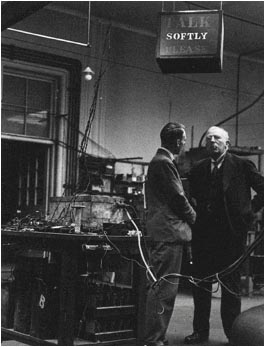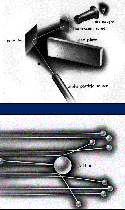 |
 1911
John Ratcliffe and Ernest Rutherford (smoking) at the Cavendish Laboratory. In 1911, Rutherford discovered the atomic nucleus, using a "scattering" experiment, diagramed at right, that would become a classic technique of particle physics. Using a lump of radium as
a source, Rutherford sent alpha particles (helium atoms minus their electrons) through a thin sheet of gold foil and observed how the particles scattered off the gold atoms.
Most passed through the foil; but, amazingly, a few particles (those that struck the dense, charged gold nuclei) bounced back. Rutherford said he was as surprised as if he had fired a gun at tissue paper and a few of the bullets had come back at him. The open door at left in the photo leads
to the laboratory in which James Chadwick discovered the neutron.
1911
John Ratcliffe and Ernest Rutherford (smoking) at the Cavendish Laboratory. In 1911, Rutherford discovered the atomic nucleus, using a "scattering" experiment, diagramed at right, that would become a classic technique of particle physics. Using a lump of radium as
a source, Rutherford sent alpha particles (helium atoms minus their electrons) through a thin sheet of gold foil and observed how the particles scattered off the gold atoms.
Most passed through the foil; but, amazingly, a few particles (those that struck the dense, charged gold nuclei) bounced back. Rutherford said he was as surprised as if he had fired a gun at tissue paper and a few of the bullets had come back at him. The open door at left in the photo leads
to the laboratory in which James Chadwick discovered the neutron.
|

 1911
John Ratcliffe and Ernest Rutherford (smoking) at the Cavendish Laboratory. In 1911, Rutherford discovered the atomic nucleus, using a "scattering" experiment, diagramed at right, that would become a classic technique of particle physics. Using a lump of radium as
a source, Rutherford sent alpha particles (helium atoms minus their electrons) through a thin sheet of gold foil and observed how the particles scattered off the gold atoms.
Most passed through the foil; but, amazingly, a few particles (those that struck the dense, charged gold nuclei) bounced back. Rutherford said he was as surprised as if he had fired a gun at tissue paper and a few of the bullets had come back at him. The open door at left in the photo leads
to the laboratory in which James Chadwick discovered the neutron.
1911
John Ratcliffe and Ernest Rutherford (smoking) at the Cavendish Laboratory. In 1911, Rutherford discovered the atomic nucleus, using a "scattering" experiment, diagramed at right, that would become a classic technique of particle physics. Using a lump of radium as
a source, Rutherford sent alpha particles (helium atoms minus their electrons) through a thin sheet of gold foil and observed how the particles scattered off the gold atoms.
Most passed through the foil; but, amazingly, a few particles (those that struck the dense, charged gold nuclei) bounced back. Rutherford said he was as surprised as if he had fired a gun at tissue paper and a few of the bullets had come back at him. The open door at left in the photo leads
to the laboratory in which James Chadwick discovered the neutron.